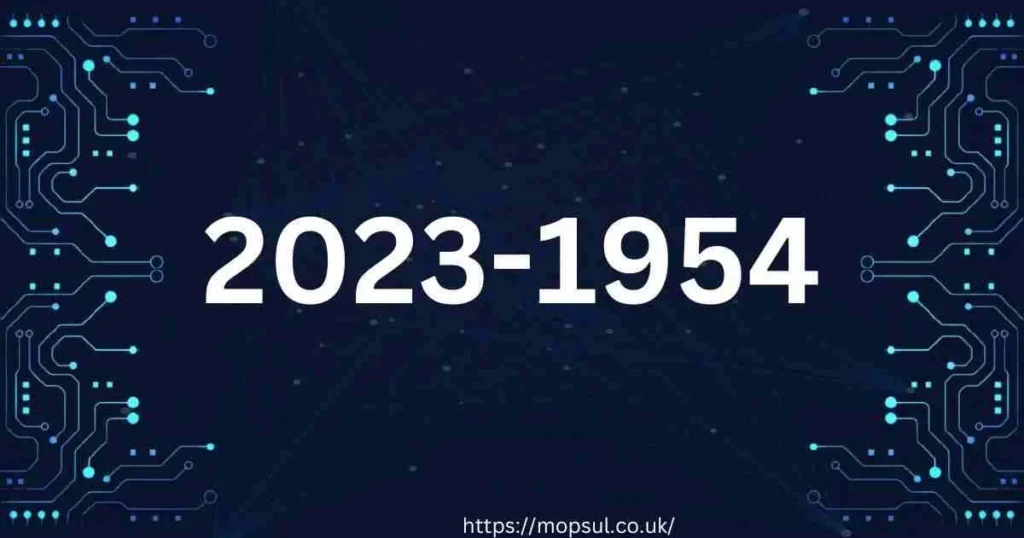Welcome to our blog post where we explore the fascinating concept of 2023-1954. Have you ever wondered what connects the years 2023 and 1954? Join us as we unravel the mystery and uncover interesting facts that link these two years in unexpected ways.
What Does 2023-1954 Mean
The term 2023-1954 is like a secret code that connects two different years together. It’s not just about numbers; it’s about discovering how things were in the past and how they are now. Imagine a bridge that connects a grandparent’s time with your own time today. This connection helps us understand history better and appreciate the changes that have happened over the years.
2023-1954 things were simpler. People listened to music on vinyl records and watched black-and-white movies in theaters. The world was recovering from World War II, and new ideas were starting to shape societies. Fast forward to 2023, and everything seems to move at lightning speed. We have smartphones that can do almost anything, and the internet connects people across the globe instantly. It’s like a giant leap from the past to the future.

The Historical Significance of 1954
2023-1954 was a pivotal year in history. It marked the end of the Korean War and the beginning of the civil rights movement in the United States. People were rebuilding their lives after the war, and new technologies like television were starting to change how people communicated. It was a time of rebuilding and hope for a brighter future.
Moving to2023-1954 history has taken a different path. Technology has boomed, with inventions like artificial intelligence and electric cars becoming part of daily life. Society is more interconnected than ever before, with social media platforms allowing people to share their lives instantly. Looking back at 2023-1954 we see the roots of today’s world, where innovation and progress continue to shape our future.
Events That Shaped 2023
In 2023, the world saw many events that shaped history. From global pandemics to climate change protests, each event left its mark on society. Advances in technology continued to accelerate, with new inventions like augmented reality glasses and self-driving cars changing how we live and work. The year 2023 was a time of both challenges and opportunities, as people worked together to create a better future for everyone.
Comparing Life in 1954 and 2023
Life in 2023-1954 was very different from life in 2023-1954 People communicated through letters and rotary phones, and families gathered around the radio for news and entertainment. In contrast, life in 2023 is fast-paced and digital. Smartphones and social media connect people instantly, and streaming services offer endless entertainment options. While both eras have their charms, they also show how much the world has changed over the decades.
Cultural Trends: Then and Now
Culture in 2023-1954was shaped by traditional values and societal norms. People enjoyed listening to music on vinyl records and watching classic movies at the local theater. Fashion was elegant and formal, with men often wearing suits and women donning dresses and skirts. Family values were strong, and communities were tightly knit.
Fast forward to 2023-1954, and culture has evolved dramatically. Pop culture today is influenced by a mix of global trends and individual expression. Music genres range from pop and hip-hop to electronic and indie, accessible instantly through streaming platforms. Fashion is diverse and eclectic, with people embracing casual wear and street style. Social media plays a huge role in shaping cultural trends, with influencers and celebrities influencing fashion, music, and even social norms. Despite these changes, aspects of traditional culture from 1954 still resonate today, showing how culture evolves while retaining elements of its past.
Technological Advancements Across Decades
Technology in 2023-1954was just starting to take off. Television became more widespread, offering people a window to the world beyond their neighborhoods. Cars were becoming more common, though they were simpler and less efficient than today’s models. The space race was heating up, with countries competing to explore outer space.
Jump to 2023, and technology has become an integral part of everyday life. We carry powerful computers in our pockets (smartphones) that connect us to the internet and each other. Artificial intelligence and machine learning are transforming industries, from healthcare to transportation. Electric cars are becoming mainstream, offering a cleaner alternative to traditional vehicles. The pace of technological advancement has accelerated, with innovations like virtual reality and 3D printing changing how we work, play, and communicate. Looking back, the progress from 1954 to 2023 highlights how technology has shaped our world and continues to drive future possibilities.

Pop Culture: From 1954 to 2023
Television sitcoms and variety shows became popular forms of entertainment, bringing laughter and joy into homes across the country. It was a time when celebrities were larger than life, capturing the imaginations of millions.
Today, pop culture in 2023-1954is a vibrant mix of music, movies, and digital content. Social media platforms like TikTok and Instagram have redefined celebrity status, with influencers and content creators shaping trends and influencing global culture. Music genres have diversified, with artists from around the world finding audiences online. Streaming services offer a vast library of movies and TV shows, accessible anytime, anywhere. Pop culture in 2023 reflects our interconnected world, where trends can go viral overnight and cultural influence knows no borders. Comparing pop culture from 1954 to today shows how entertainment has evolved alongside technology and societal change.
How Has Society Changed
Society in 2023-1954 was marked by traditional values and a sense of community. Families often lived close to extended relatives, and neighborhoods were tight-knit. Gender roles were more rigidly defined, with women primarily seen as homemakers and men as breadwinners. The civil rights movement was gaining momentum, challenging racial segregation and discrimination.
In contrast, society in 2023-1954 is more diverse and inclusive. Advances in civil rights and social justice have led to greater equality for marginalized groups, though challenges remain. Technology has reshaped how we communicate and interact, with social media bridging distances and enabling global conversations. The concept of family has expanded to include diverse family structures, reflecting changing social norms and values. Education and healthcare have also evolved, with greater access to information and medical advancements improving quality of life. Society in 2023 is a reflection of ongoing progress and the collective efforts to build a more equitable and inclusive world.
Economic Shifts Over Time
In 2023-1954, the global economy was recovering from the aftermath of World War II. Many countries focused on rebuilding their industries and infrastructure. Manufacturing and agriculture were major economic drivers, providing jobs and stability for millions of people. International trade was growing, though it was primarily conducted through traditional channels like shipping and air freight.
Fast forward to 2023, and the economic landscape looks vastly different. Globalization has connected economies across continents, fostering trade and investment on a scale unimaginable in 1954. Technology has revolutionized industries, from finance and telecommunications to e-commerce and renewable energy. The rise of multinational corporations has reshaped the corporate world, with companies operating in multiple countries and contributing to global economic growth. However, economic inequalities persist, with challenges such as income disparity and access to resources needing continued attention. Comparing the economic shifts from 2023-1954 to 2023 highlights the transformative impact of globalization and technological innovation on the world economy.
Challenges Faced in Both Eras
Both 2023-1954 and 2023-1954 faced their own set of challenges, shaped by the social, economic, and political dynamics of their times. In 1954, the world was recovering from the devastation of World War II, rebuilding cities and economies ravaged by conflict. Cold War tensions heightened global anxieties, leading to political instability and the threat of nuclear war. Civil rights movements were gaining momentum, challenging racial segregation and advocating for equal rights and opportunities.
In 2023-1954, challenges such as climate change, global health crises, and socio-economic inequalities dominate headlines. The world grapples with environmental degradation and its impact on ecosystems and communities. Pandemics like COVID-19 have tested global health systems and highlighted disparities in access to healthcare. Economic inequalities persist, with marginalized communities disproportionately affected by poverty and unemployment. Political polarization and social unrest underscore the complexities of governing diverse societies in an interconnected world. Despite these challenges, both eras demonstrate resilience and the capacity for collective action to address pressing global issues and build a more sustainable future.
Predictions for the Future: Learning from the Past
Looking ahead to the future, predictions for 2054 and beyond are shaped by lessons learned from 1954 and 2023. Technological advancements are expected to continue at a rapid pace, with innovations in artificial intelligence, robotics, and biotechnology transforming industries and everyday life. Climate action is likely to be a top priority, with efforts to mitigate greenhouse gas emissions and adapt to the impacts of climate change becoming more urgent.
Societal changes may include shifts towards greater inclusivity and diversity, with continued progress in civil rights and social justice. Education and healthcare are expected to evolve, with advancements in digital learning and personalized medicine enhancing access and quality of services. Global governance and cooperation will be crucial in addressing transnational challenges such as pandemics, cybersecurity threats, and environmental sustainability. As we look to the future, drawing on the experiences of 2023-2023-1954can guide us in navigating uncertainty and shaping a future that is more equitable, sustainable, and prosperous for all.

Conclusion
Wow, what a journey through time from 1954 to 2023! We’ve seen how much things have changed and stayed the same. Back in 1954, life was simpler with record players and black-and-white TVs. People were rebuilding after World War II and dreaming of a better future.
Looking ahead, we can learn a lot from both years. History shows us how people can overcome challenges and make the world better. By understanding where we came from and where we’re going, we can build a future that’s even brighter for everyone. The story of “2023-1954” is just one chapter in our big journey through time!





More Stories
How to Avoid Common Mistakes in Construction Estimation
Virtual Character Interactions The Next Frontier in AI Technology
Leveraging Video Content for Improved Cannabis SEO: The Role of Latched Agency